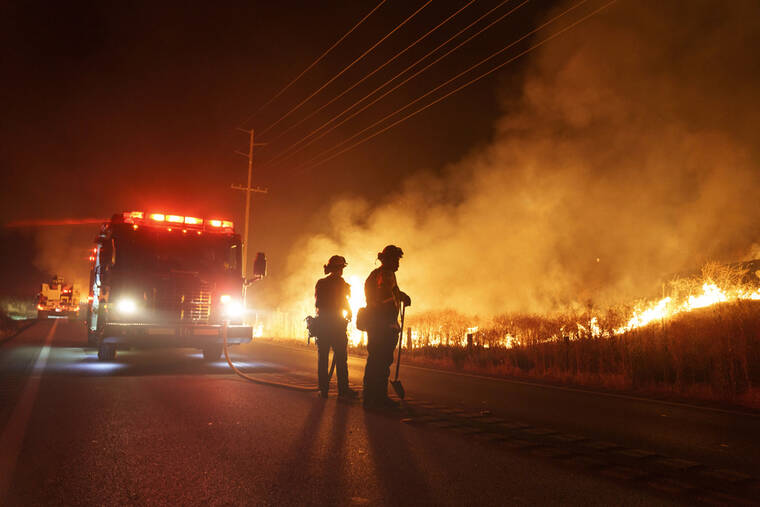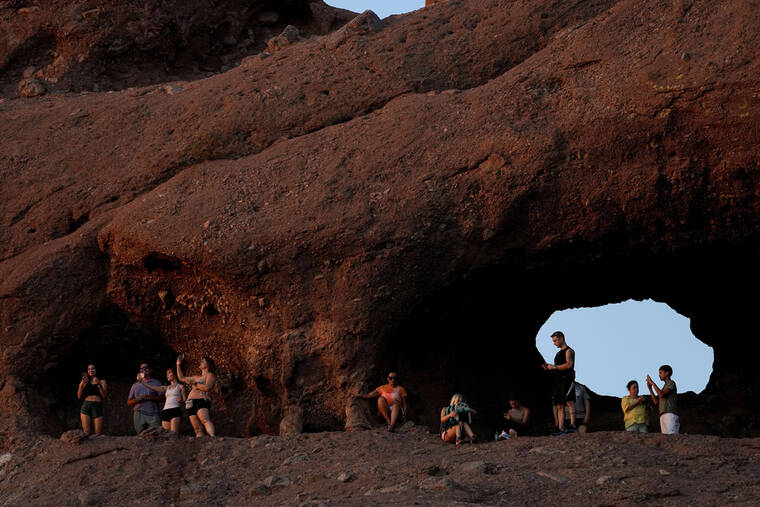US swelters under dangerous heat wave

Firefighters monitor as flames consume brush along Gilman Springs Road during the Rabbit Fire late Friday, July 14, 2023, in Moreno Valley, Calif. (AP Photo/Eric Thayer)

Hikers watch the sunset at Papago Park, Friday, July 14, 2023 in Phoenix. Phoenix hit 112 degrees on Friday, marking the city’s 15th consecutive day of 110 degree-plus temperatures and putting it on track to beat the longest measured stretch of such heat. The record is 18 days, recorded in 1974. Desert residents accustomed to scorching summers are feeling the grip of the heat wave hitting the Southwest this week.(AP Photo/Matt York)
PHOENIX (AP) — A dangerous heat wave threatened a wide swath of the Southwest with potentially deadly temperatures in the triple digits on Saturday as some cooling centers extended their hours and emergency rooms prepared to treat more people with heat-related illnesses.
PHOENIX (AP) — A dangerous heat wave threatened a wide swath of the Southwest with potentially deadly temperatures in the triple digits on Saturday as some cooling centers extended their hours and emergency rooms prepared to treat more people with heat-related illnesses.
“Near record temperatures are expected this weekend!” the National Weather Service in Phoenix warned in a tweet, advising people to follow its safety tips such as drinking plenty of water and checking on relatives and neighbors.
“Don’t be a statistic!” the weather service in Tucson advised, noting extreme heat can be deadly. “It CAN happen to YOU!”
Over 110 million people, or about a third of Americans, were under extreme heat advisories, watches and warnings Saturday as the blistering heat wave was forecast to get worse this weekend for Nevada, Arizona and California. Temperatures in some desert areas were predicted to soar past 120 degrees Fahrenheit (48.8 degrees Celsius) during the day, and remain in the 90s F (above 32.2 C) overnight.
Around 200 hydration stations distributing bottles of water and cooling centers where potentially thousands of people can rest in air-conditioned spaces opened Saturday in public spaces like libraries, churches and businesses around the Phoenix area.
Charles Sanders spent Friday afternoon with his Chihuahua mix Babygirl at the air-conditioned Justa Center, which offers daytime services to older homeless people in downtown Phoenix. It’s also serving as a hydration station, distributing free bottles of water.
Because of funding and staffing limitations, the center can only stay open until 5:30 p.m., so Sanders, a 59-year-old who uses a wheelchair, has spent the sweltering nights with his pet in a tattered tent behind the building.
“I’ve been here for four summers now and it’s the worst so far,” said Sanders, a former welder originally from Denver.
David Hondula, chief heat officer for the City of Phoenix, said Friday that because of the health risks some centers were extending hours that are sometimes abbreviated because of limited volunteers and money.
“This weekend there will be some of the most serious and hot conditions we’ve ever seen,” said Hondula.
He said just one location, the Brian Garcia Welcome Center for homeless people in downtown Phoenix, planned to be open 24 hours and direct people to shelters and other air-conditioned spaces for the night. During especially hot spells in the past, the Phoenix Convention Center has opened some space as a nighttime cooling center, but Hondula said he had not heard of that possibility this year.
Stacy Champion, an advocate for homeless people in Phoenix, took to Twitter this week to criticize the lack of nighttime cooling spaces for unsheltered individuals, saying they are “out of luck” if they have no place to go.
In Las Vegas, casinos offered respite from the heat for many. Air-conditioned libraries, police station lobbies and other places from Texas to California planned to be open to the public to offer relief for at least part of the day.
Emergency room doctors in Las Vegas have been treating more people for heat illness as the heat wave threatened to break the city’s all-time record high of 117 degrees Fahrenheit (47.2 degrees Celsius) this weekend.
Dr. Ashkan Morim, who works in the ER at Dignity Health Siena Hospital in suburban Henderson, Nevada, spoke Friday of treating tourists this week who spent too long drinking by pools and became severely dehydrated, and a stranded hiker who needed liters of fluids to regain his strength.
In New Mexico’s largest city of Albuquerque, splash pads will be open for extended hours and many public pools were offering free admission. In Boise, Idaho, churches and other nonprofit groups were offering water, sunscreen and shelter.
In Southern California, temperatures soared into the triple digits in inland areas, and a ridge of high pressure was expected to keep its hold on the region for a couple of weeks.
By mid Saturday afternoon, it was 122 degrees Fahrenheit (50 degrees Celsius) in Death Valley, California, where forecasters have said the temperature could hit 130 degrees Fahrenheit (54.4 C) this weekend. The hottest temperature recorded at Death Valley was 134 F (56.6 C) in July 1913, according to the National Park Service.
In Lancaster and Palmdale, north of Los Angeles, temperatures hit 108 degrees Fahrenheit (42.2 degrees Celsius), said National Weather Service meteorologist Mike Wofford. In Los Angeles’ San Fernando Valley, the thermometer cleared triple digits in some areas.
“We are going to be pretty warm for a while,” Wofford said, adding that temperatures would be above normal for about two weeks. “There’s been a lot of triple digits” across the region.
In Los Angeles, Mayor Karen Bass announced the city was opening cooling centers where residents can escape the heat. “The extreme heat that is forecasted this weekend can pose serious risks,” she warned.
The hot, dry conditions sparked a series of blazes in Southern California southeast of Los Angeles, where firefighters Saturday were battling three separate brush fires amid blistering heat and low humidity in sparsely populated, hilly areas. The fires were all within 40 miles (65 kilometers) of each other in Riverside County, where temperatures in some areas spiked into the triple digits.
“Heat is definitely a concern out there,” said April Newman of the Cal Fire/Riverside County Fire Department, adding that the blazes were burning through dense, dry brush in rugged terrain.
Phoenix on Saturday saw the city’s 16th consecutive day of 110 degrees Fahrenheit (43.3 degrees Celsius) or higher temperatures, hitting that mark before noon and putting it on track to beat the longest measured stretch of such heat. The was record 18 days, in 1974.
By late afternoon, the temperature in Phoenix had hit 118 degrees Fahrenheit (47.8 degrees Celsius), breaking the daily record set on July 15, 1998, of 117 F (47.2 C), the National Weather Service in Phoenix tweeted. The normal high for the date is 107 F (41.6 C).
Emphasizing how dangerous the heat can be, police in the Phoenix suburb of Surprise said Saturday its officers on Friday found two older women sweltering at home in 114 degrees Fahrenheit (45.5 degrees Celsius) with just a tiny, overtaxed unit that failed to cool most of the house. After the women were taken to senior center to cool off, the department’s community services team bought and installed an adequate air conditioner and several fans in the home.
Extreme heat is especially dangerous for older people; medications they may take or chronic conditions like heart or kidney disease can make it harder for their bodies to cool down.
Regional health officials in Las Vegas launched a new database Thursday to report “heat-caused” and “heat-related” deaths in the city and surrounding Clark County from April to October.
The Southern Nevada Health District said seven people have died since April 11, and a total of 152 deaths last year were determined to be heat-related.
Arizona’s Maricopa County, home to Phoenix, reported this week that so far this year there have been 12 confirmed heat-associated deaths going back to April, half of them people who were homeless. Another 55 deaths are under investigation.
There were 425 confirmed heat-associated deaths in Maricopa County last year, with more than half of them occurring in July and 80% of them happening outdoors.
Closer to the Pacific coast, temperatures were less severe, but still have made for sweaty days on picket lines in the Los Angeles area, where actors joined screenwriters in strikes against producers.
In Sacramento, the California State Fair kicked off with organizers canceling planned horseracing events due to concerns for animal safety. Pet owners around the Southwest were urged to keep their animals mostly inside.
Associated Press reporters Michael Blood in Los Angeles, Ken Ritter in Las Vegas, and Susan Montoya in Albuquerque, New Mexico, contributed to this report.


